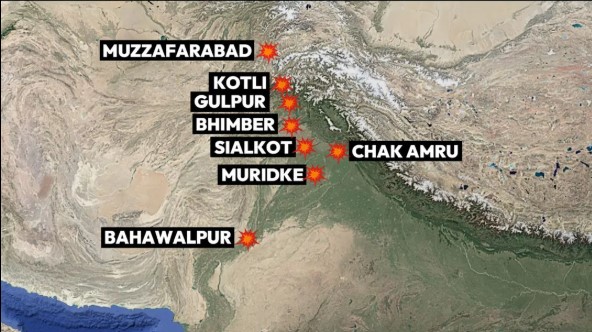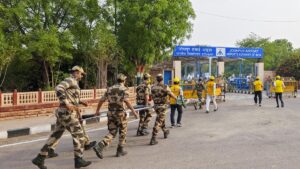Indian armed forces strike terror camps in Pakistan and PoK through Operation Sindoor

Indian Armed Forced carried out Operation Sindoor on 9 Terror camps in Pakistan and PoK
Indian armed forces carried out 24 precision missile strikes on nine terror targets in Pakistan and Pakistan-Occupied Kashmir (POK), including Muridke and Bahawalpur which were strongholds of terror groups Lashkar-e-Taiba and Jaish-e-Mohammed (JeM). The operation was a retaliatory response to the April 22, 2025, Pahalgam terror attack in Jammu and Kashmir, which killed 26 civilians, mostly tourists, including 25 Indian men and one Nepali national. The attack specifically targeted Hindu and non-Muslim men, leaving many women widowed, which deeply influenced the operation’s naming.
The operation involved coordinated efforts by the Indian Army, Navy, and Air Force, utilizing advanced precision strike systems, including Rafale jets, SCALP cruise missiles, Hammer Smart Bombs, and loitering munitions. The strikes, executed between 1:05 AM and 1:30 AM from Indian territory, targeted key terror bases linked to banned groups Jaish-e-Mohammed (JeM), Lashkar-e-Taiba (LeT), and Hizbul Mujahideen. Notable targets included:
- JeM sites: Markaz Subhan Allah in Bahawalpur, Sarjal in Tehra Kalan, Markaz Abbas in Kotli, and Syedna Bilal camp in Muzaffarabad.
- LeT sites: Markaz Taiba in Muridke, Markaz Ahle Hadith in Barnala, and Shwawai Nalla camp in Muzaffarabad.
- Hizbul Mujahideen sites: Makaz Raheel Shahid in Kotli and Mehmoona Joya in Sialkot.
These sites were chosen for their roles in planning and executing cross-border terrorist attacks, including the Pahalgam massacre and earlier incidents like the 2019 Pulwama bombing. The operation was described as “focused, measured, and non-escalatory,” avoiding Pakistani military facilities to minimize escalation risks. Reports indicate at least 70 terrorists were killed, including 10 family members and four aides of JeM chief Masood Azhar.
The codename “Sindoor,” carries symbolic significance. Sindoor, or vermilion, is a red powder traditionally worn by married Hindu women to signify their marital status. The name serves as a tribute to the women who lost their husbands in the Pahalgam attack, symbolizing both the grief of the widows and India’s resolve to deliver justice. It also reflects a cultural nod to strength and honor, as sindoor is sometimes associated with warriors in Indian tradition.
Government of India emphasized that the strikes were based on credible intelligence linking Pakistan-based terrorists to the Pahalgam attack. Foreign Secretary Vikram Misri and military officials, including Colonel Sofiya Qureshi and Wing Commander Vyomika Singh, briefed the media, highlighting the operation’s precision and intent to dismantle terror networks.
The operation sparked significant domestic and international reactions. Indian leaders across political parties, including Rahul Gandhi and Amit Shah, praised the armed forces, while border states were placed on high alert. The operation also led to flight cancellations across northern India and heightened security measures, including mock drills and civil defense preparedness.
Internationally, India briefed allies like the US, France, and Japan, with former UK PM Rishi Sunak supporting India’s right to strike terrorist infrastructure. Operation Sindoor marks a doctrinal shift in India’s counter-terrorism strategy, signaling a willingness to use conventional military force against subconventional threats, challenging Pakistan’s deterrence assumptions. It builds on previous operations like the 2016 surgical strikes and 2019 Balakot airstrikes but is notable for its scale, targeting multiple sites deep in Pakistan, and its symbolic naming, which humanizes the victims while projecting resolve.




